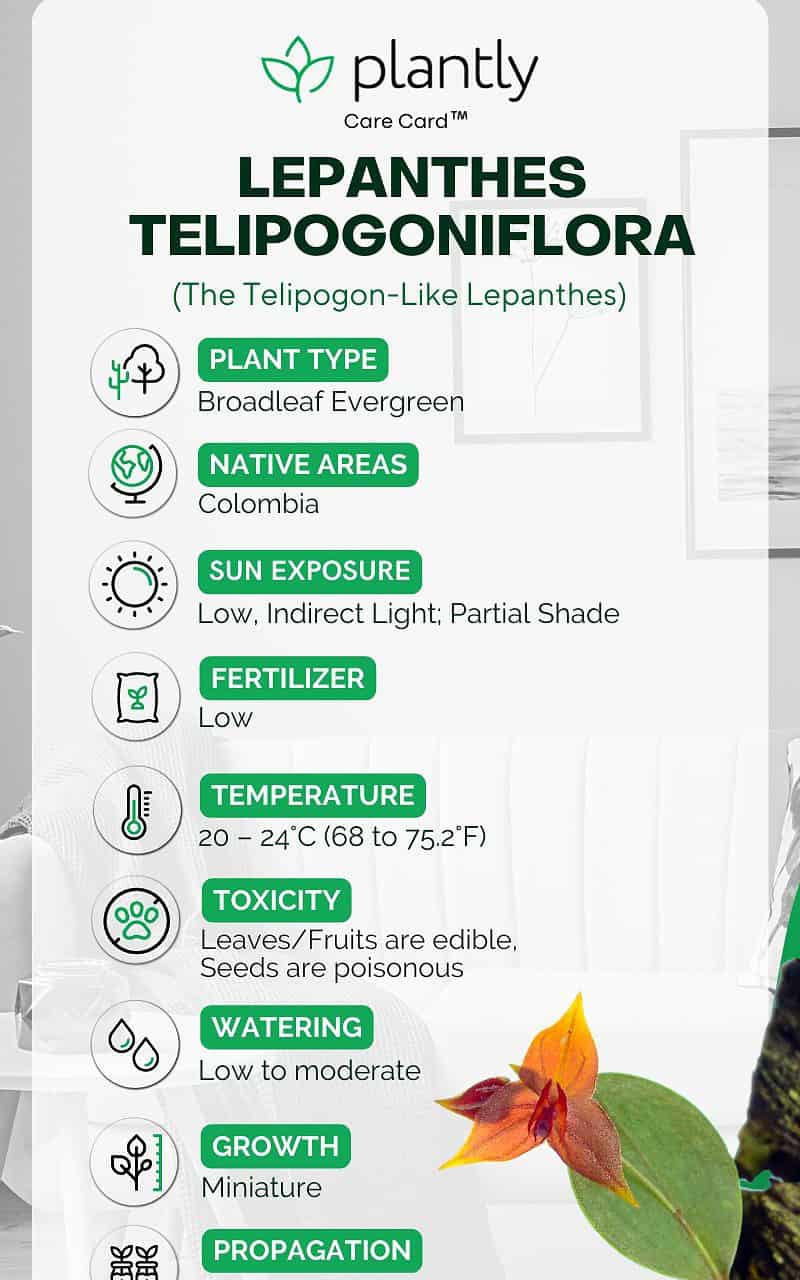No products in the cart.
Table of Contents
What’s interesting about Lepanthes telipogoniflora is that it has a miniature size. For an orchid plant, this species is surprisingly tiny. Its green leaves could reach only a maximum size of 1 cm.
But what you can’t ignore about this mini-orchid is the orange flowers that it produces. It has a size that’s almost twice larger than the leaves making it an eye-catcher.
This small orchid is endemic to Columbia where it can be found in lowland forests. Since it’s an epiphyte, you’d normally see them anchored in tree trunks, living under canopies. But because of its attractive appearance, it wasn’t hard for this plant to capture the attention of many gardeners.
Thus, Lepanthes telipogoniflora became another rare houseplant.
If you’re interested to grow lepanthes, here’s the basic information you have to know about this plant.

Lepanthes Telipogoniflor Plant Care Basics

Tending to a Telipogoniflora lepanthes plant can be demanding. Since the plant is very small, you have to spend extra time taking care of it to make sure that it thrives well. The key is to provide the best growing conditions.
Following are the care tips that will be helpful for you.
Choose Soilless Potting Mix
The lepanthes genus is a huge group that consists of orchid species. Thus, they can be mounted epiphytically on a surface for them to grow. They won’t need the regular potting soil that we use on the majority of our houseplants.
What you need is a soilless mixture of fine bark with perlite or sphagnum moss. You can plant your lepanthes on this medium and it will be just fine. To mount this plant, you may also use net pots, wood slabs, or cork overlaid with moss.
Keep Light Low and Indirect

In its natural habitat, telipogoniflora lepanthes thrives under wide tree canopies. The lush greenery of forests provides them with partial shade. This makes them more acquainted with low-level and indirect light. Bright light is not needed at all. In fact, it may even be detrimental to the plant’s health. It’s not really hard to keep it shaded since it’s quite small.
In a terrarium setup, this mini-orchid will benefit from the shade of other larger plants.
Provide Regular Watering
Keep in mind that this lepanthes species is used in a wet environment. When kept indoors, it will need frequent watering to keep the soilless medium damp. If you don’t water regularly, the sphagnum moss may easily dry up, leaving your orchid dehydrated.
You can use a small bottle to spray water on the medium and unto the whole plant. That should be enough to saturate the environment with enough moisture.
Ensure a Warm Environment
A temperature ranging between 20 – 24°C (68 to 75.2°F) is ideal for the L. telipogoniflora. This condition is a bit warm. So, make sure your plant is situated in such kind of environment. However, please also avoid exposure to excessive heat such as direct sunlight or heat drafts.

Additionally, this plant won’t tolerate too much cold. If your area is colder, we suggest that you grow this plant indoors.
Maintain a High Humidity Level
Maintaining high humidity is very crucial for this species. In order to keep your tiny plant happy and healthy, make sure that the air surrounding it is always moist. Regular misting is the key to achieving this. We told you, this little charmer can be difficult to please.
Enclosing the plant in a container such as in a terrarium setup is helpful to maintain humid conditions. If you don’t have much time to mist, we recommend that you use this method.
Apply a Low Dose of Fertilizer
The requirement for fertilizer is low. There’s no need for regular feeding. As a rule of thumb, fertilize only when necessary. You may add a low-dose fertilizer during the growing period. This will help your plant access all the required nutrients for it to flourish.
Be cautious, however, not overfertilize your orchids as this can lead to death. Stop fertilizing when the winter season comes.
Propagate After a Few Years
Due to its diminutive size, propagation can be a struggle. Typically, you can propagate through division in order to multiply your plant. If your plant has already developed many spikes, it’s now ready for propagation. However, it may take years before it’s able to do so.
Another factor is that it may be risky to divide the plant because the roots may easily get damaged.
Today, the more advanced way to propagate is by tissue culture. This is a more efficient technique. But this is only done by nurseries that have laboratories where they can cultivate.
Growth Zone
This species can grow in almost all growing zones provided that you keep its environment moist, humid, and shaded.
Potting and Pruning
Normally, you won’t need to repot this plant unless the medium has decomposed or been depleted. Unlike in other species, you have to retain the growing media in the plant’s roots before you transfer it. This is because the tiny roots are heavily anchored and it will destroy them if you try to remove the moss around it.
There’s no need to prune this plant.
Other Lepanthes Species and Similar Plants
Have you now developed an interest in collecting miniature orchids? If yes, then here’s a list of other lepanthes species that you may want to add to your Lepanthes telipogoniflora. They almost have the same requirements for growth so it’s a great idea to combine them together.
Lepanthes lucifer

Another miniature orchid that is a relative of Lepanthes teipogoniflor is the Lepanthes lucifer. It is native to Ecuador and is characterized by bright red blooms. The plant leaves have a mixture of dark green and burgundy colors.
Lepanthes tentaculata

These species produce flowers that are a bit smaller than the telipogoniflora. Each bloom has a size of only 5 mm. The colors are a combination of red and yellow flowers. Like Lepanthes lucifera, this species is also native to Ecuador.
Lepanthes Telipogoniflor Diseases & Pests
The common pests you’ll encounter with orchids include mealybugs, aphids, scales, and spider mites. You may spray them off with diluted horticultural oils to keep them from multiplying. Remember your plant is very tiny. It won’t be that hard for the pests to cover the entire plant if left untreated.
Fungal diseases such as leaf spots, blights, and leaf spots and root rot can possibly infect your orchid. The highly humid conditions can cause these fungi to proliferate. To prevent this, make sure that there’s enough air movement around your tiny houseplant.
Frequently Asked Questions
Both Lepanthes telipogoniflora and Lepanthes tentaculata are miniature in size. They are related to each other in that they belong to the same genus. The flower of L. tentaculata, however, is much smaller than its leaves. It’s characterized by having tentacles.
Compared to that of Lepanthes telipogoniflora, the Lepanthes saltatrix has patterned leaves and miniature flower. Both species belong to the Lepanthes genus.
Lepanthes tsubotae look almost similar with L. telipogoniflora. The distinct difference, however, is that its flowers look like butterflies and it has colors of light to dark pink.
Plantly has the best line of choices for your houseplant hunting. Browse our page to see the rare species that we have to offer. Enjoy shopping!
Whether you want to buy, sell or simply reach out to other plant enthusiasts, Plantly is the right place to be!


